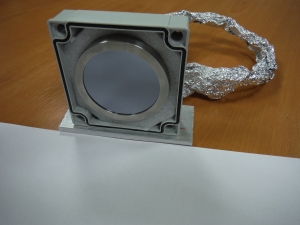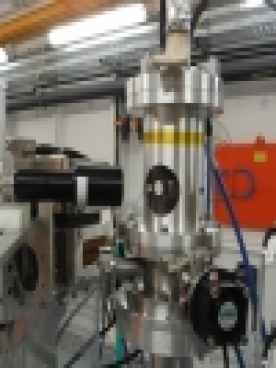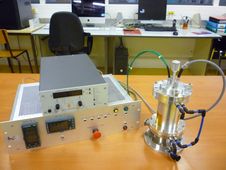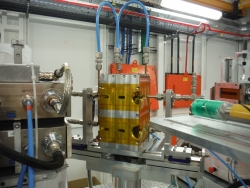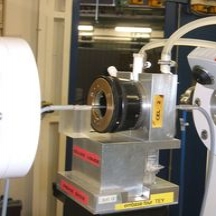
ROCK : Rocking Optics for Chemical Kinetics
ROCK est une ligne de spectroscopie d’absorption X en mode quick-EXAFS dans le domaine 4 - 40 keV
La ligne de lumière ROCK est une ligne de spectroscopie d’absorption X en mode quick-EXAFS dans le domaine 4 - 40 keV.
 Financée par l’ANR dans le cadre des Projets Investissements d’Avenir (Equipex 2010), ROCK est dédiée à l'étude des processus cinétiques rapides sur des nanomatériaux utilisés principalement dans le domaine de la catalyse et des batteries. Le but de cet EQUIPEX est de contribuer au développement de catalyseurs et de batteries plus performants qui devraient trouver des applications industrielles dans le domaine de la production et du stockage de l'énergie en conformité avec la protection de la santé publique et de l’environnement.
Financée par l’ANR dans le cadre des Projets Investissements d’Avenir (Equipex 2010), ROCK est dédiée à l'étude des processus cinétiques rapides sur des nanomatériaux utilisés principalement dans le domaine de la catalyse et des batteries. Le but de cet EQUIPEX est de contribuer au développement de catalyseurs et de batteries plus performants qui devraient trouver des applications industrielles dans le domaine de la production et du stockage de l'énergie en conformité avec la protection de la santé publique et de l’environnement.
L'équipe
Collaboratrice associée
IADECOLA Antonella (RS2E CNRS)
![]() 01 69 35 94 68
01 69 35 94 68
![]() antonella.iadecola@synchrotron-soleil.fr
antonella.iadecola@synchrotron-soleil.fr
Données techniques
4.5 à 40 keV
2 10-4 à 5 10-5
Aimant de courbure (Ec = 8.65 keV)
Si(111) @ 8.0 keV : 2 1012ph/s
Si(220) @ 20 keV : 5 1011ph/s
Miroir toroïdal courbable en Si recouvert de 50nm d'Ir ;
2 monochromateurs QuEXAFS (Si111 et Si220) entre un miroir plan et un miroir courbable en Si à trois pistes (Pd, Pt et B4C) assurant le rejet des harmoniques
Dispositifs ancillaires pour la catalyse (Fours, rack distribution gaz, spectromètre de masse ...)
Cellules électrochimiques thermostatable, multipotentiomètre
Spectromètres Raman et UV-visible
Calorimétrie différentielle à balayage
350 µm à 4.9 mm de large (FWHM)
79 µm à 2.2 mm de hauteur (FWHM)
Chambres à ionisation OKEN
Photodiode à avalanche
Thématiques scientifiques
| Nanomatériaux | utilisés principalement dans le domaine de la catalyse et des batteries |
|---|
Des informations détaillées sur les miroirs et monochromateurs de la cabane optique, sur la station EXAFS. Retrouvez également les Setups disponibles sur ROCK, les techniques couplées et les particularités de la ligne.
Cabane optique

Schéma de la cabane Optique
Storage ring : Toroidal collimating mirror M1 (CINEL/Winlight X)
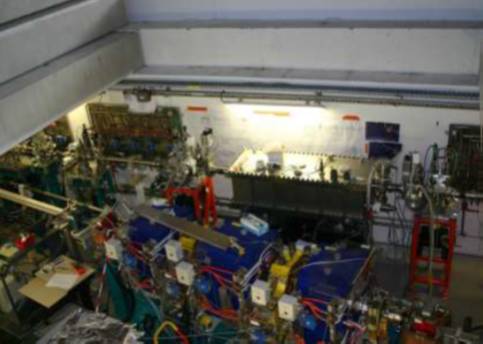

M1
Ir (50 nm)
Roughness 5 Å <
Tangential slope error: 0.5 μrad RMS
Sagittal slope error : 20 μrad RMS
Water Cooled
Total absorbed power : 87 W
Absorbed power density : 4 mW/mm 2
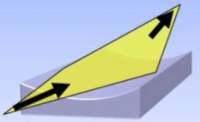 Collimating principe :
Collimating principe :
Optical hutch : Mirrors M2a and M2b harmonic rejection and vertical focusing (IRELECALCEN/Winlight X)
|
|
|
|
| Acceptance | 1.5 (H) x 1.0 (V) mrad2 | 1.5 (H) x 1.0 (V) mrad2 |
| Source distance | 16.82 m | 22.44 m |
| Optical active area | 47 mm x 1100 mm | 47 mm x 1100 mm |
| Coating | 3 stripes Pt layer 50 nm, Pd layer 50 nm and B4C layer 5 nm | 3 stripes Pt layer 50 nm, Pd layer 50 nm and B4C layer 5 nm |
| Roughness | less than 3 Ǻ RMS | less than 3 Ǻ RMS |
| Longitudinal slope error | 1 µrad RMS/best spherical fit | 1 µrad RMS/best spherical fit |
| Sagittal slope error | 5 µrad RMS | 5 µrad RMS |
| Orientation | Reflecting vertically upward | Reflecting vertically qownward |
| Working pitch angle |
1.75 mrad to 5.2 mrad |
1.75 mrad to 5.2 mrad |
| Shape | Flat mirror : R > 20 km | Bending radius range : 1.5 km < R < 20 km |
| Cooling system | Water cooling | No cooling |
| Maximum total absorbed power | 78 W | - |
| Maximum absorbed power density | 19 mW/mm2 | - |
Quick-EXAFS monochromator

Expected flux at the focusing point
The SOLEIL designed Quick-EXAFS monochromators are made of two independent channel-cut crystals (Si(111) and Si(220)) and was first used on SAMBA beamline. Each channel-cut crystal is mounted on a cam driven tilt table allowing it to oscillate periodically with amplitude θ(t) around an average fixed Bragg angle θB. The amplitude can be tune from 0.1 to 4° by an original SOLEIL in vacuum variable cam design. The θB Bragg angle is selected by one of the two goniometers holding the oscillating tilt tables. The 4.5 to 40 keV energy range is available using both Quick-EXAFS monochromators. The channel-cut crystal can be changed by the other one in few seconds during an experiment allowing to record quick-EXAFS data at absorption edges very far in energy. For instance the XAS study of a bimetallic catalyst at both edges during the same catalytic reaction is now possible with the SAMBA’s QuEXAFS set-up, even if the edge energies of those elements are covered by two distinct crystals.

Quick-exafs monochromator
Maximum performance of the Quick-EXAFS mechanics in terms of oscillation frequency of the channel-cut is 40 Hz for two recorded spectra: one with the Bragg angle collection in the downward direction and the other with the Bragg angle collection in the upward direction. Due to the photon flux available at the sample position at the SAMBA beamline in QuEXAFS configuration ((flux ~ 1011 ph/s at 8 keV) the optimal time resolution of experiments on real concentrated and not too absorbing samples is around 100 ms. On ROCK we expect to reach 1012 ph/s in 50 ms.
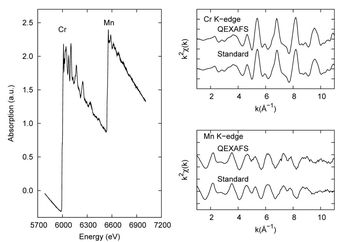
(left) Absorption of stacked Cr and Mn metallic foils measured over an amplitude of 3.6 °. Data are the average of 10 spectra each collected at 1Hz. (right) k2 weighted Quick-EXAFS are compared to standard scans taken in almost 15 min.
Related publications:
The SAMBA Quick-EXAFS monochromator: XAS with edge jumping
E. Fonda, A. Rochet, M. Ribbens, S. Belin, L. Barthe, V. Briois
Journal of Synchrotron Radiation (2012), 19, p 417 - 424
Cabane EXAFS
►Quick-exafs Mode
Crystal type : Si111 Si220 Si311 (4 to 40 keV)
Beam size : from 350 x 79 µm2 to 4.9 x 2.2 mm2
Flux ~ 1012 ph/s at 8 keV
Transmission

Oken ionization chambers
Fluorescence APD ou PIPS

Avalanche Photo Diode (APD)
PIPS
Edge Jump
Large energie range from 4 keV (Si111) to 37 keV (Si311) in 30s
The remote selection of the monochromator crystals, Si(111) or Si(311), allowing users to permanently access energies between 4 and 37 keV in Quick-exafs mode.

E. Fonda, A. Rochet, M. Ribbens, S. Belin, V. Briois The SAMBA quick-EXAFS monochromator: XAS with edge jumping J. Synchrotron Rad. 2012, 19, 417 – 424.
Example of the energy range accessible with Si111 cam=4°
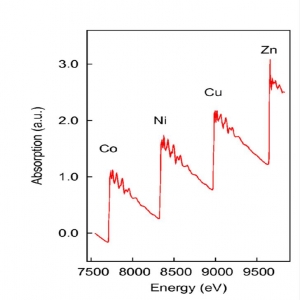
Setups disponibles
Couplages
ROCK's experimental station EXAFS is characterised by a lot of techniques combined to XAS, such as Differential Scanning Calorimetry, Raman Spectroscopy and UV-Visible Spectroscopy.
|
XAS with Raman spectroscopy Kosi RXN1-785 Kaiser |
Iexc. = 785 nm or 532 nm CCD: 100-3450cm-1 or 200-4000 cm-1 Optical fibers with probehead Seceral Long Working Distance objectives (150 mm to 35 mm) |
|
XAS with UV-visible spectroscopy  Cary 50 VARIAN
|
With optical fibers 190 < I < 1100 nm VScan < 24000 nm/min XAS cell with mylar or PP windows for optical fiber used in transmission or immersion probe : 2 or 10 mm or cuvettes Quartz, Glass, PMMA, PS |
XAS with Raman and UV-Visible spectroscopies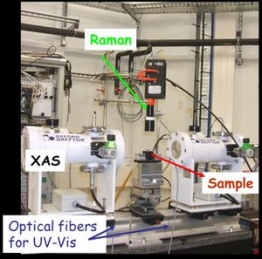 |
|
| XAS with Differential Scanning Calorimeter (DSC) DSC 111 Setaram : 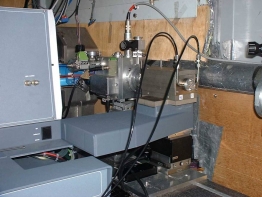 Calvet type differential scanning calorimeter |
* Phase transition (fusion, crystallization, glass transition, polymerization, degradation) * Cp Evaluation * Monitoring of reactions (oxidation, reduction, dehydration...) |
Catalyse
Retrouvez ci-dessous les différents environnements échantillons catalyseurs à votre disposition sur la station EXAFS.
|
Polyvalent SOLEIL development for fluorescence, transmission and Raman coupling La Fontaine, C., Barthe, L., Rochet, A., & Briois, V. |
Two ovens/capillaries set-up collaboration MAX IV/SOLEIL designed by L. Barthe
|
Characteristics
Characteristics 2 capillaries oven
|
|
High pressure cell for transmission and Raman coupling A. Rochet et al. Catalysis Today (2011) vol 171 186-191 |
 |
Characteristics
|
|
Commercial cell Harrick for fluorescence and Raman coupling C. La Fontaine et al. Harrick Scientific Products (Ed.), Application Note n°91201 (2010). |
 |
Characteristics
|
|
Gas distribution system |
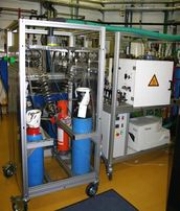  |
|
|
Mass spectrometer |
 |
MKS Cirrus
|
Basse temperature
With the courtesy of SAMBA beamline
| Helium Cryostat |  |
He cryostat suitable for transmission and fluorescence detection (20 K to Room Temperature) |
| Nitrogen Cryostat |  |
Liquid nitrogen (80 K) cryostat suitable for transmission and fluorescence detection |
Cellules liquides
We have different cells with fixed or variable optical path available for basic or acidic solution. Two of them are thermostatically controlled. Note Kapton, Mylar, PP or PTFE can be used as windows depending of the nature of the solution.
| Liquid cell with variable optical path for transmission | 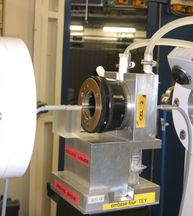 |
Thermostated liquid cell (PTFE) with adjustable optical paths (10 µm to 6 mm) suitable for the combination of transmission XAS with UV-Vis spectroscopies (design SPECA) |
| Liquid cell for transmission |  |
Liquid cells PTFE with fixed optical paths (0.5<o.p.<5mm) |
| Liquid cell for fluorescence mode |  |
Liquid cell (PCTFE) for fluorescence detection (design F. Villain) |
| Liquid cell for biological sample |  |
PTFE sample-holder for He cryostat With the courtesy of SAMBA beamline |
| Thermostated liquid cell |
|
Thermostated liquid cell (PCTFE) with adjustable optical paths (100µm to 10mm) suitable for the combination of transmission XAS with Raman and/or UV-Vis spectroscopies
Thermostated liquid cell (PTFE) with adjustable optical paths (10µm to 6mm) suitable for the combination of transmission XAS with UV-Vis spectroscopies (design SPECA) |
Science de l'Energie
Setup for Li/Na batteries
 |
VMP3 Bio-logic Multi-channel Potentiostat 16 independent channels, 6 already equipped (+/-400mA) whose one for impedance measurement |
 ANR ANR |
Electrochemical cell dedicated to operando XAS J. B. Leriche et al. J. Electrochem. Soc., 157, (5) A606-A610 2010 |
 |
Multicell support |
 |
Furnace RT to 90°C for 2 electrochemical cells for example |
 |
Thermostated support |
Notices
EXAFS :
QuickExafs
TBT_cryostats.pdf
Informations aux utilisateurs, préparation des échantillons, la charte SOLEIL des utilisateurs et une aide à la soumission de projets sont disponibles en ligne.
Aide à la soumission de projets
Comment préparer votre demande de temps de faisceau ?
Les soumissions de projet doivent suivre le modèle prédéfini suivant : Renseignement du "formulaire" en ligne, concernant la partie générale du projet.
- Description scientifique et expérimentale
- Annexes des images (format .jpeg .png)
- Description des conditions expérimentales nécessitant des précautions spéciales de sécurité
- Soumission du projet
(S'il s'agit de la continuation d'un projet, il est nécessaire de soumettre un rapport d'expérience(s) passée(s) dans le SUN set et inclure la (les) publication(s) correspondante(s) avant de soumettre votre nouveau projet)
L'ensemble de la demande doit être rédigé en anglais
De plus,
- Il est nécessaire de contacter un des scientifiques de la ligne, pour discuter de l'adéquation du projet avec les spécificités de la ligne de lumière en particuliers au sujet des environnements échantillons, du mode de détection ou d'acquisition.
- La justification du temps de faisceau demandé est indispensable.
N'oubliez pas de mentionner vos publications liées à la ligne dans le sunset.
Pour plus d'informations : Le guide général des Utilisateurs
Préparation des échantillons
Gaz
The application for the use of specialty gases must be stipulated in your proposal in order that the security service can assess the associated risks. Specialty gases must be commanded 8 weeks before your experiment, also you have to prevent your local contact well in advance, for common gases (helium, argon, nitrogen, hydrogen, air and oxygen) only 2 weeks are sufficient.
Helium liquid
The application for the use of helium liquid must be stipulated in your proposal and recalled to your local contact in such a way to order sufficiently in advance the suitable volume.



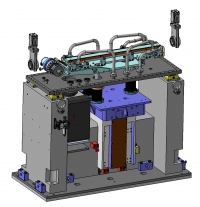 M2a
M2a
